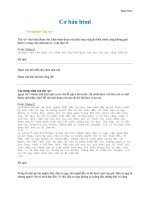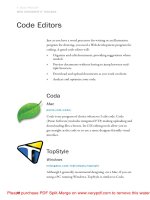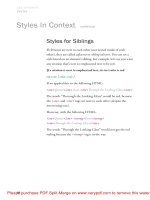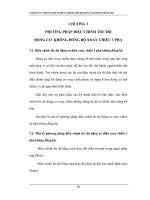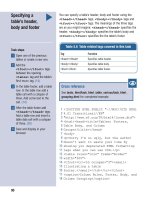Tài liệu Speaking in styles- P3 doc
Bạn đang xem bản rút gọn của tài liệu. Xem và tải ngay bản đầy đủ của tài liệu tại đây (1.44 MB, 50 trang )
78
CSS GRAMMAR
SYNTAX
Styles for Siblings
If elements are next to each other (not nested inside of each
other), they are called adjacent or sibling selectors. You can set a
style based on an element’s sibling. For example, let’s say you want
any citation that’s next to emphasized text to be red:
If a citation is next to emphasized text, its text color is red.
em+cite { color: red; }
If we applied this to the following HTML:
<em>Quotes</em> om <cite> rough the Looking-Glass</cite>
e words “ orough the Looking-Glass” would be red, because
the <em> and <cite> tags are next to each other (despite the
intervening text).
However, with the following HTML:
<em>Quotes</em> <strong> om</strong>
<cite> rough the Looking-Glass</cite>
e words “ rough the Looking-Glass” would not get the red
styling because the <strong> tag is in the way.
Styles In Context
continued
Please purchase PDF Split-Merge on www.verypdf.com to remove this watermark.
79
em+cite{ color: red; }
If a citation is directly next to emphasized text,
its color is red.
Plus Sign
<em> Quotes</em> om
<cite>rough the Looking-Glass</cite>
em+cite{ color: red; }
<em> Quotes/em> om
<cite>rough the Looking-Glass</cite>
Please purchase PDF Split-Merge on www.verypdf.com to remove this watermark.
80
CSS GRAMMAR
SYNTAX
Although primarily intended to add styles to particular elements
created using HTML tags, there are several cases where we can
use CSS to style content on the page that is not speci cally set o
by HTML tags or to create a dynamic style in reaction to some-
thing that your Web site visitor is doing on the screen. ese are
known as pseudo-elements and pseudo-classes:
Link pseudo-classes: Used to style hypertext links.
Although primarily associated with color, you can actually
use any CSS property to set o links and provide user feed-
back during interaction.
Dynamic pseudo-classes: Used to style any element on the
screen depending on how the user is interacting with it.
Pseudo-elements: Used to style the rst letter or rst line in
a block of text.
Link States
All hypertext links have four “states” that can be styled in reac-
tion to a user action:
a link state when there has been no action
a hover state when the mouse cursor is over it
an active state when the user clicks it
a visited state when the user returns a er having visited the
linked-to page
Styles for Special Cases
Please purchase PDF Split-Merge on www.verypdf.com to remove this watermark.
81
Link Hover
Active Visited
Please purchase PDF Split-Merge on www.verypdf.com to remove this watermark.
82
CSS GRAMMAR
SYNTAX
Styles for Link Actions
Although the link tag can be styled just like any other HTML
tag, it is a special case, because people visiting your site can inter-
act with it. It’s a good practice to create di erent styles to react to
what the visitor is doing. To that end, CSS includes four di erent
pseudo-classes for each of the four interaction states: link, visited,
hoer, and active:
e default link text color is red.
a:link { color: red; }
If the link is in the browser history, its text color is dark red.
a:visited { color: darkred; }
When the visitor hoers over a link, its text color is hot pink.
a:hoer { color: hotpink; }
When the visitor clicks a link, its text color
is fuchsia.
a:active { color: fuchsia; }
Collectively, these are known as the link pseudo-
classes. ey need to be in the above order—link,
visited, hover, active—to function properly, due
to the cascade order, which we’ll learn more
about in the next chapter. It’s also important to
remember that, while links are typically associ-
ated with color, any style can be applied to a link.
Designing Interaction
In Chapter 10, “Navigation” we’ll dou-
ble do
wn on how to use the link and
dynamic pseudo-classes to create a
variety of interactive styles for but-
tons and other controls. It’s important
for you to expand your notion of Web
site design to include the interactive
elements. Often I see visual comps
from designers that look great but
are static. Don’t ignore the fact that
people are using your site.
Styles for Special Cases
continued
Please purchase PDF Split-Merge on www.verypdf.com to remove this watermark.
83
a:link { color: red; }
a:visited { color: darkred; }
a:hover { color: hotpink; }
a:active { color: fuchsia; }
<a href="index.html">Wel c ome … </p>
e default link text color is
red.
If the link is in the browser history, its text color is
dark red.
When the visitor hovers over a link, its text color is
hot pink.
When the visitor clicks a link, its text color is
fuchsia.
Please purchase PDF Split-Merge on www.verypdf.com to remove this watermark.
84
CSS GRAMMAR
SYNTAX
Styles for Dynamic Actions
e hover and active states are not just for links. You can actually
place your cursor over and click on any element on the screen and
style elements for those actions. e third action state is when the
user selects an element on the screen (usually a form eld) and
that element is in focus and it is ready for user input.
e default text color for the class formField in an input box
is gray.
input.formField { color: gray; }
When the user hoers over an input eld with the formField
class, its text color is green.
input.formField:hoer { color: green; }
When the user clicks an input eld with the formField class, its
text color is red.
input.formField:active { color: red; }
While the user is typing in an input eld with the formField
class, its text color is black.
input.formField:focus { color: black; }
Collectively these are called the dynamic pseudo-classes, which
allow you to provide interactive feedback to the user. Dynamic
pseudo-classes can be applied to any element on the screen but
are chie y used to add dynamic interaction to form elds and
buttons, which we will look at in Chapter 10, “Navigation & UI”
One drawback: IE7 does not support active and focus, and IE6
supports none of these.
Styles for Special Cases
continued
Please purchase PDF Split-Merge on www.verypdf.com to remove this watermark.
85
e default text color for the class formField in
an input box is gray.
When the user hovers over an input eld
with the formField class, its text color is green.
When the user clicks an input eld with the
formField class, its text color is red.
While the user is typing in an input eld with
the formField class, its text color is black.
input.formField { color: gray; }
input.formField:hover { color: green; }
input.formField:active { color: red; }
input.formField:focus{ color: black; }
<input class="formField" type="text" />
Please purchase PDF Split-Merge on www.verypdf.com to remove this watermark.
86
CSS GRAMMAR
SYNTAX
Styles for Parts of a Paragraph
To draw attention to an introduction or opening statement, one
common practice is to make the rst letter or rst line of text in
a paragraph stand out from the rest of the text on the page. A
paragraph is a block of text, so it has a rst letter and a rst line
of characters, but they do not have speci c HTML tags around
them. To style these you can use pseudo-elements for the rst-
letter and rst line:
e rst letter of each paragraph is red.
p: rst-letter { color: red; }
e rst line of each paragraph is blue
p: rst-line { color: blue }
Keep in mind, though, that this applies the style indiscriminately
to all paragraph tags on the page. If we want to style only the rst
letter or line of the rst paragraph in our content, we would need
to style it based on its context as the rst child of a particular ele-
ment (let’s ID it as content).
e rst letter in a paragraph within any tag with the content
ID has a color of red.
#content+p: rst-letter { color: red; }
<div id="content"><p>One thing was certain…</p></div>
e only drawback to this method is that it will not work in IE6,
which does not recognize the child context.
Styles for Special Cases
continued
Please purchase PDF Split-Merge on www.verypdf.com to remove this watermark.
87
e rst letter of each paragraph is red.
e rst line of each paragraph is blue.
p:rst-letter { color : red; }
Colon
p:rst-line { color : blue; }
Colon
<p>One thing was certain…</p>
p:rst-letter { color : red; }
p:rst-line { color : blue; }
<p>One thing was certain…</p>
<p>e way Dinah…</p>
Please purchase PDF Split-Merge on www.verypdf.com to remove this watermark.
Please purchase PDF Split-Merge on www.verypdf.com to remove this watermark.
C
HAPTER
5
Semantics
Making Sense of Styles
When we speak to each other, we understand as much from the
context of our words as from the words themselves. To be under-
stood, we need to be clear about the context of our statements.
We use semantics to do this, putting ideas together in a logical
manner. We don’t think about it, it’s an instinct like breathing—
we do it all the time.
In CSS, where you place your styles de nes where and how they
will be applied. You need to understand how styles cascade down
the document, and how to apply di erent styles depending on
the medium. With a bit of practice, the semantics of CSS will
also become as instinctual as speaking or even breathing.
Please purchase PDF Split-Merge on www.verypdf.com to remove this watermark.
90
CSS GRAMMAR
SEMANTICS
In Chapter 4, I cleverly avoided showing you exactly where to
put your CSS code. Instead I showed it disembodied from the
HTML code it was intended to style. However, where you put
your CSS code in relation to your HTML code has a direct
impact on how it works and what elements it a ects. ere are
three places to put your CSS code, depending on the scope of ele-
ments you want your styles to de ne:
01 Inline Styles placed directly into an HTML tag using the
style attribute.
02 Embedded Styles placed in an HTML <style> tag and
then applied to that Web page.
03 External Styles placed in a separate le and made acces-
sible by any Web page using the <link> tag or @import rule.
Threadless
threadless.com
T-shirt styles in a well designed site—that’s
Threadless.
Where to Put Style Rules
Please purchase PDF Split-Merge on www.verypdf.com to remove this watermark.
91
Please purchase PDF Split-Merge on www.verypdf.com to remove this watermark.
92
CSS GRAMMAR
SEMANTICS
Inline Styles for an HTML Tag
So far, I have shown you examples of a complete CSS rule, con-
sisting of a selector and a declaration:
h1 { color: red; }
However, CSS allows you to use the style attribute to place style
declarations directly into an HTML tag:
<h1 style="color: red;"> rough the Looking-Glass</h1>
is is called placing the style inline. It has the same e ect on the
style of the level 1 header tag as the full CSS rule, but only a ects
that single instance of the tag. All other level 1 headers on the
page remain una ected.
You can add as many di erent styles as you want to the style attri-
bute, as long as you separate each declaration by a semicolon:
<h1 style="color: red; font-family: Georgia; text-align: center;">
rough the Looking-Glass</h1>
Although useful for quickly adding styles where they are needed
in a design, inline styles have two major drawbacks that diminish
the exibility of CSS, so they should be used sparingly if at all:
01 Because inline styles a ect only that one tag in that one
instance, you can’t easily make global changes to styles.
02 Inline styles are the nal word on what styles are applied to
that element, so they cannot be overridden.
I sometimes use inline styles while developing a site to quickly
test out ideas, but before my Web pages go live, I take inline styles
out of my HTML code and replace them with classes or IDs.
Where to Put Style Rules
continued
Please purchase PDF Split-Merge on www.verypdf.com to remove this watermark.
93
<h1 style="color : red;" >
rough the Looking-Glass
</h1>
Style Attribute Declaration
HTML Tag
Inline Style:
Affects only the tag it is in.
Please purchase PDF Split-Merge on www.verypdf.com to remove this watermark.
94
CSS GRAMMAR
SEMANTICS
Embed Styles in a Web Page
Styles that are meant to a ect an entire Web page (but not nec-
essarily an entire Web site) are embedded into the HTML code
using the HTML <style> tag, which will contain CSS rules:
<style type="text/css" media="all">
h1 { color: red; }
.hilight { background-color: yellow; }
#slide01 { border: 1px solid blue; }
</style>
Embedded styles will be applied to any relevant elements in the
page. Making a change to any of the rules in this list will a ect
all of the elements on the page that
are a ected by that rule. e type will
always be “text/css” (yes, there are other
types; no, no one uses them). We will
discuss media types later in this chap-
ter, but the default is “all,” to tell the
browser the styles should be applied to
all media types.
Where to Place the Style Tag
You can place the <style> tag anywhere in the
<head> or <body> of your HTML document, but
I str
ongly recommended that you place this
code in the <head> and above any JavaScript
you might have on the page. Why? You want
these styles to be applied as quickly as pos-
sible, before the content is displayed. If you
place it after JavaScript or in the body of your
HTML, there is a strong chance that the browser
will start displaying the content before it has
deciphered your style rules, and there will be
an annoying fl ash as the page disappears and
then reappears with the appropriate styling.
Where to Put Style Rules
continued
Please purchase PDF Split-Merge on www.verypdf.com to remove this watermark.
95
<style type="text/css" media="all">
h1 { color : red; }
</style>
Style Tag Style Type
CSS Rule
Embedded Style:
Affects the entire page it is on.
Media Type
Close Tag
Please purchase PDF Split-Merge on www.verypdf.com to remove this watermark.
96
CSS GRAMMAR
SEMANTICS
External Styles in a Web Site
Although inline and embedded styles allow you to add CSS to
Web pages, the real power of CSS comes when you apply styles
to an entire Web site. Instead of changes a ecting a single page or
tag, you can change dozens or thousands of pages by switching a
single style. To do this, you need to set up an external style sheet,
and then link it to a Web page or import it into a Web page or
another external style sheet.
For example, say you have a Web page called main.html, with
your content structured using HTML. To style this le, you
would create an external style sheet called default.css, and place
a <link> tag or @import rule in the HTML le pointing to the
external style sheet. ose styles will now be applied to the Web
page just as if the code was embedded in it. However, we could
also link that same le to more les—for example ch01.html or
ch02.html—and get the same styles applied to the content on
those pages.
However, you are not limited to a single external style sheet. If
you need to tailor the design of each page, you can link to or
import additional style sheets to mix and match styles. For exam-
ple, you can have a ch01.css and a ch02.css style sheet to customize
those pages with their own backgrounds (or anything else you
need). To cut down on the number of les you are linking to,
you could import default.css into ch01.css and ch02.css to get the
same results.
Where to Put Style Rules
continued
Please purchase PDF Split-Merge on www.verypdf.com to remove this watermark.
97
Please purchase PDF Split-Merge on www.verypdf.com to remove this watermark.

